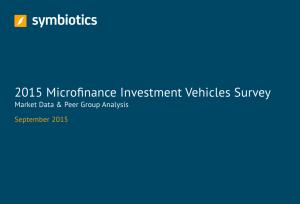 I still remember how a CGAP colleague and I wrote the first report on investment funds investing into microfinance. The task was not so easy since the real financial sector terminology and our donor-focused microfinance lingo was very much out of tune. We would ask for “committed” capital or “disbursed” and where only answered by blank eyes or silence. It was difficult to report on debt and equity going into microfinance since we were also not quite clear if we were looking for the overall portfolio or the amounts newly invested every year. Some of the resulting CGAP publications were “MIV Performance and Prospects” and “Microfinance Investment Vehicles.” The investment funds were coined “microfinance vehicles (MIVs)”, the CGAP MIV Disclosure Guidelines were published, and the exercise is now in its ninth edition which is now prepared annually by Symbiotics. Their latest report just came out on September 15 2015 which they announced in a press release on September 16 2015. Let me tell you a little about its findings:Data sources (84 MIVs):
I still remember how a CGAP colleague and I wrote the first report on investment funds investing into microfinance. The task was not so easy since the real financial sector terminology and our donor-focused microfinance lingo was very much out of tune. We would ask for “committed” capital or “disbursed” and where only answered by blank eyes or silence. It was difficult to report on debt and equity going into microfinance since we were also not quite clear if we were looking for the overall portfolio or the amounts newly invested every year. Some of the resulting CGAP publications were “MIV Performance and Prospects” and “Microfinance Investment Vehicles.” The investment funds were coined “microfinance vehicles (MIVs)”, the CGAP MIV Disclosure Guidelines were published, and the exercise is now in its ninth edition which is now prepared annually by Symbiotics. Their latest report just came out on September 15 2015 which they announced in a press release on September 16 2015. Let me tell you a little about its findings:Data sources (84 MIVs):
- Independent investment entities with more than 50% of their non-cash assets invested in microfinance and open to multiple investors;
- Microfinance investment funds that are not open to multiple investors. These are classified as “Other Microfinance Investment Intermediaries (MIIs)” as per the CGAP MIV Disclosure guidelines*.
 The Survey sample does not include microfinance funds of funds as to avoid any double counting of microfinance investment volumes.
The Survey sample does not include microfinance funds of funds as to avoid any double counting of microfinance investment volumes.
The sample (as of December 31 2014):
- Out of 110 vehicles which represent the identified universe, 84 MIVs (96%) were included in the survey;
- Total assets under management (AuM) of the 84 MIVs: USD10.4 bn
- Of the 84 surveyed MIVs, 49 are fixed income funds, 21 are mixed/hybrid funds, and 14 are equity funds. Equity funds witnessed the largest growth in term of total assets (+16%).
- Participating MIVs are managed by 43 different asset managers in 16 countries. The top 3 asset managers manage 43% of the sample total assets.
Main findings:
Institutional investors remain the prime funding resource for MIVs (51%) but capital from the public sector has grown significantly in 2014 (+17%).
Growth in total assets turned out to be higher than what MIVs had forecasted for 2014 (i.e. 13% using a USD constant FX rate vs. 10% forecasted). Still, it remains lower than in past years and this trend is expected to continue as MIVs forecast a 6% total asset growth in 2015. The microfinance portfolio has increased faster than total assets (i.e. 15.8%) in 2014. The microfinance portfolio has increased by 78% since 2010. Growth in 2014 was slower than in 2013, but all MIVs still recorded steady growth of 13% in total assets, and 16% in microfinance assets.
The microfinance investment market remains concentrated both in terms of total assets and microfinance portfolio. The top 5 MIVs maintained their market share level in 2014 (45%). The microfinance portfolio was more concentrated than in 2013 as the top 20 MIVs now represent 77% of the market (vs. 71% in 2013).
The 84 MIVs surveyed are managed by 43 different asset managers located in 16 countries. Thirty percent of the microfinance portfolio is managed from Switzerland, 25% from the Netherlands. American asset managers have the most MIVs under management (23%).
 The proportion of the microfinance portfolio as a percentage of total assets has steadily been increasing over the past years. The ratio has gone from 70% in 2009 to 80% as of December 2014. MIVs have gradually reduced their share of liquidities which stands at 12% in 2014 (vs. 16% in 2009). In terms of target investees, MIVs mostly finance “large” microfinance investees, those that have more than USD 100 million in total assets. Only 6% of the microfinance portfolio of MIVs was allocated to microfinance investees with less than USD 10 million in total assets.
The proportion of the microfinance portfolio as a percentage of total assets has steadily been increasing over the past years. The ratio has gone from 70% in 2009 to 80% as of December 2014. MIVs have gradually reduced their share of liquidities which stands at 12% in 2014 (vs. 16% in 2009). In terms of target investees, MIVs mostly finance “large” microfinance investees, those that have more than USD 100 million in total assets. Only 6% of the microfinance portfolio of MIVs was allocated to microfinance investees with less than USD 10 million in total assets.
MIVs continue to channel their microfinance portfolio mainly through debt instruments invested directly in microfinance investees (82.6%). Getting exposure through other microfinance investment intermediaries (i.e. indirect microfinance portfolio) remains a tiny portion of the MIVs’ total microfinance portfolio (3%).
MIVs had a higher currency risk exposure with the unhedged portion of local currency debt investments amounting to 16.1% of direct debt investments (vs. 13.2% in 2013). Another indicator that increased is the percentage of loan loss provisions which represented 2.6% at the end of 2014 compared to 1.1% as of December 2013.
MIV investment in other sectors than microfinance amounts to USD 7.9 million on average, representing 7% of MIVs’ total assets. Close to 60% of this volume is targeted at financing “Other Activities” such as SMEs, education, healthcare, fair trade and investments in other market instruments. Additionally, one third of the “Other Portfolio” finances organizations involved in agriculture-related activities.
MIVs’ yield on direct debt microfinance portfolio were stable in 2014 on a weighted average basis (6.8% vs. 6.9% the previous year). If a constant exchange rate is applied to the income and debt portfolio figures, the weighted average yield for 2014 is above the 7% level.
Survey participants invested in 102 countries:
- Eastern Europe & Central Asia is the largest regional exposure of all MIVs as the geographical allocation remains in line with last year.
- Africa (Sub-Saharan Africa + Middle East & North Africa) is the fastest growing continent measured on an annual basis (21%) as well as in a 5-year timeframe (+211% since 2010).
- Cambodia was the country in which MIVs invested the most, representing 8% of their direct microfinance portfolio, followed by India (6.9%) and Azerbaijan (6.5%).
- Together, the top 10 countries receive more than half of MIVs’ direct microfinance portfolio (52%).
- While the top 10 countries exhibit some similarities between Fixed Income Funds and Mixed Funds, the distribution is much different for Equity Funds that mostly target India (51%).
Number of active borrowers financed reach close to 260,000. Microfinance investees from an MIV portfolio display an average loan size to end-clients of USD 1,622, an indicator that has been decreasing since 2012 and stands at its lowest level since 2009 (USD 1,553). Sixty-six percent of borrowers are female and 49% live in rural areas.
Voluntary savers represent 58% of microfinance investees’ active borrowers. Micro-enterprise loans remain the prime product offering of microfinance investees while loans for immediate household needs slightly increased from 11% in 2013 to 13% in 2014. As for other types of products, only 9.3% of microfinance investees from the MIV portfolio make use of mobile banking, either by incorporating it in their business process or by acting as agents of mobile money providers.
Client Protection Principles from the Smart Campaign have been largely endorsed by participating MIVs (99%) whereas only a small portion of their investees (25%) have undergone a Smart Assessment.
Management fees and Total Expense Ratio (TER) remain stable while slightly decreasing across the 2013-2014 period for a constant sample of 44 MIVs.
Overall, net returns to investors have increased as unlevered vehicles performed over the 3% mark in 2014 for USD, EUR, and CHF share classes.

